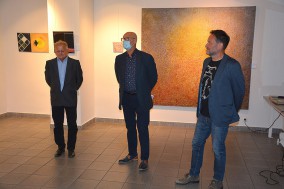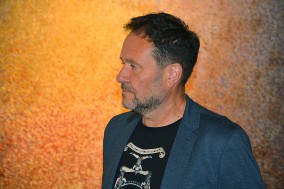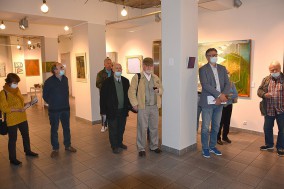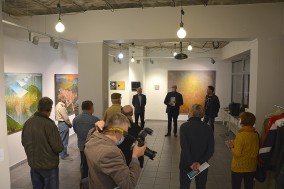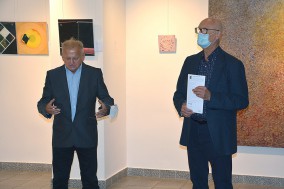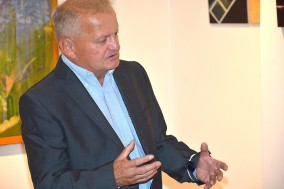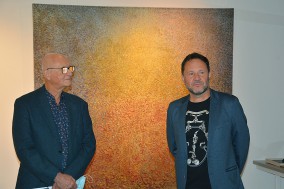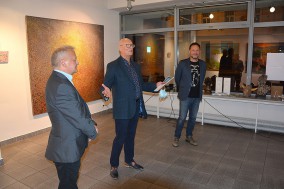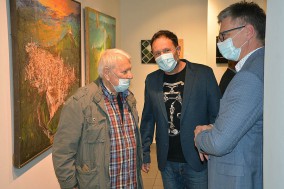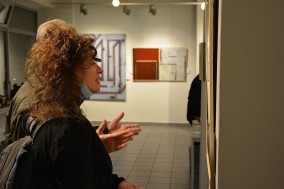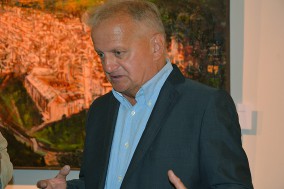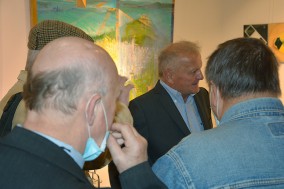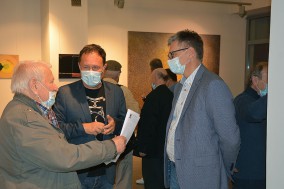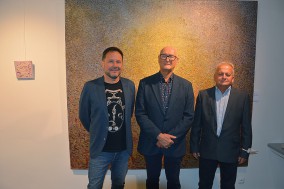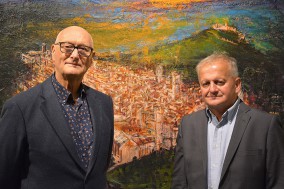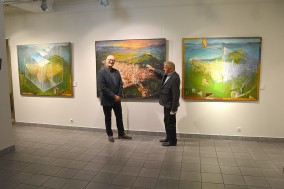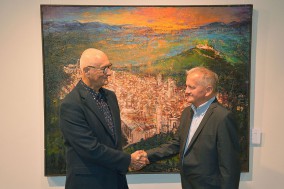
Two words - paintings
06 October 2021 - 06 November 2021
ABOUT EXHIBITION
ArtistMr Grzegorz Ratajczyk is a colourful and multidimensional character. He is an artist, draughtsman, graphic artist, pedagogue, traveller, nature admirer, connoisseur, gourmet, but most of all he is a painter. He works wherever he happens to be, because work is one of the important meanings of his fulfilment. He lives in Poznań, is a professor at the Poznań University of Arts and runs a painting studio. He works with students at all levels of education - from preliminary etudes in the first year of studies to master's diplomas.
Work
Grzegorz Ratajczyk's work is built on his experiences, thoughts and reflections.
and in this sense it is very real, because - just like in life - these threads interweave into one. Recently, this work has been realised mainly in drawings and paintings, although colourful spatial objects have also been created.
Mr Ratajczyk ostentatiously uses traditional techniques: he paints watercolours and oil paintings, draws with a pen, pencil and crayons, but he does not avoid experimenting - he creates drawings on stones and paintings on wood, colourful objects suspended in space or intended for... bees and left to them.
This is an artist who seeks beauty in a classical way. Before modernism, art was not divided into utilitarian and artistic, everything created in the visual sphere, not only that, had to be useful and reflect beauty in a huge number of varieties and categories formulated since antiquity.
Thus, you are dealing with painting that is beautiful in the formal layer, revealing and inquisitive in the layer of meaning, as this dimension is extremely important for the artist. In this way, he realises the exploratory postulate that art becomes an instrument for learning about reality, sometimes more effectively than science, as suggested by Albert Einstein and Jerzy Nowosielski.
Mr Ratajczyk's art is about the world of spirit and matter, it is beautiful and true. I encourage you to contemplate it.
Prof. Janusz Stankowski
Punat na KRK, 18 September 2021
Paweł Lewandowski-Palle
in pursuit of a dream or painting of struggle
Ten years ago, in his Autoreferat, a kind of artistic credo, written for the purpose of the application for a professorial title, Andrzej Zdanowicz wrote "What then is painting for me? Painting, which can be a craft, a prayer, a way of self-discovery, a manifestation of personality. And rather, it is never reduced to just one of these planes. It is like caput mortuum paint - brown, but also violet. Red, but also blue, and most often with all its possibilities. Painting is my caput mortuum."
It is difficult with this CAPUT MORTUUM. It can be poisonous. The majority of artificial, poisonous iron roses are obtained from roasting calcotar with lead oxide. However, there are quite a few non-poisonous varieties. It definitely sounds best in combinations with whites, giving a wide range of purple tones. Caput mortuum was/is also an alchemical symbol of the Templars - it is the so-called dead head symbolising mortal life. The name "caput mortuum" is also used today to describe the motif of three skulls known from the gothic subculture. Zdanowicz uses the caput mortuum. With success. In fact, it is also what makes his colour distinctive and original. And in terms of works of art, small and very small formats of painting notes and concepts are transferred onto larger sub-images. With a clear logic of actions, with taking original assumptions to new paths, with checking the concept, bypassing it, synthesising, simplifying to make it more visible. All this is an attempt to orientate myself in the chances of the winning image, how much I can win - after all, in the end it is all about the winning images. I wonder whether Zdanowicz, who appreciates the classic achievements of the SBB formation, follows the motto: Seek - Destroy - Build? Searching and building are obvious, but does he demolish? He sets himself new challenges. New concepts are both a continuation and a search for something new. This is one of the characteristics of maturity. It does not close itself off to something that may be a trap of stagnation and self-replication. He searches, checks and returns in a complicated path of resolution, on his way to another, "better" painting. Nothing in this painting is closed once and for all. Full of thought and concentration, he searches for the optimal solution.
The most important thing, however, are the reasons which develop into ideas. There is no such thing as good painting about anything, wrote Rothko, Newman and Gottlieb in the New York Times on 13 June 1943. The giants were right. I repeat after them: painting is not more or less skilful painting. Of course, Zdanowicz understands this perfectly. I am sure that he would not paint about nothing, well, maybe at the entrance exam, when the topic of the specialist task was: "A painting about nothing". Painting is a reflection for him. These "bomb" in him. The impulse of his ideas is ... EVERYTHING, including art. Concreteness. I believe in the authenticity of his reasons.
I collect "Zdanowicz." It started with the intimate oil painting "Minus 20 degrees Celsius" from 2006. Its large (165 x 120 cm) version was completed in 2014. While maintaining the parallelism of the architectural structures, it is not a copy of the original concept. On top of the cool, variegated greys, the painter has introduced dark cuts or grooves tending towards black, and within them he has placed thin red lines. The whole is dotted with grey holes, as if after a series of rifle bullets. Looking at this painting for the first time made me feel cold. How it resonates with the classics of Polish political posters of 1981,
with Jan Bokiewicz's "13", dripping with blood, Michal Jędrczak's red holes or Piotr Młodożeniec's white and red flag dripping with blood. "Minus 20" is one of the most interesting pictures about the December events, those on the coast or later in front of the mine... Zdanowicz does not narrate, but EXPRESSES. The association with Polish December or June was and remains a strong element of reflection. In the summer of 2021, at the STALOWA Gallery, I had the opportunity to see Jerzy Brukwicki's curatorial exhibition: "STRAJK" - a reference to the "Polish months". I thought of the imagery and wise painting of Zdanowicz, who years ago wrote: "War panoramas, battles, skirmishes, clashes have always been among the subjects overly eagerly taken up by painters". I do not know whether Zdanowicz takes up these difficult subjects willingly, but I know that he paints very clever pictures about them, which is exemplified by his latest picture "Story" painted for the exhibition "FOURTY" in the Regional Museum in Bydgoszcz to commemorate the 40th anniversary of the introduction of martial law.
Andrzej Zdanowicz is one of the most interesting painters of the generation born in the 1960s. His diploma paintings were painting stories about the violence of human relations. Their surface grew out of gesture painting contrasted with the plane of colour. In a sense, they were oriented towards sign and meaning. He completed his diploma in painting under the guidance of Jan Świtka, but a very important element of his "education" was contact with Norbert Skupniewicz, whose assistant he became. He abandoned gesture painting quite quickly, perhaps already after the "arsenal" exhibition, noticing the multiplicity of rather one-sided statements. The beginning of more than twenty years of cooperation with Skupniewicz seems to me to be a breakthrough for Zdanowicz's painting. First of all, he noticed the charge of energy in seemingly simple combinations of planes. His search oscillated in the space between object, sign and meaning. Between the real and the metaphysical.
The breakthrough, KEY painting was the reflection of Siena - "Red Siena" (115 x 80 cm) completed in 1993. The first version of this theme: two reds and two blues overlaid somewhat Rothko-like. Since then, complicating the surface of the painting through the form derived from geometric notation has become the field of his artistic creations. A later version (2004) has offered definitely stronger contrast and a delicate expansion of the colour scale by adding two pink-red tones.
The hero of the presented paintings by Andrzej Zdanowicz seems to be precisely THE LINE, while the artist's works are not to be found among the classics of this problem in Polish art exhibitions. Reflecting on the reasons for this situation, it seems that, first of all, he is oriented towards the painting as a painting, with all its classical features, and that, in a sense, he is a separate artist.
The line appears in Zdanowicz's painting at the turn of the century. It begins to play a significant role in this painting very quickly. The combinations of plane and linear forms, telling stories in a linear way, have enough "spurts" which decide about the "freshness" of the proposal. Sometimes a line is the same thickness of an outline, turning into an intricate arabesque, separated in small and irregular fragments by mysterious lights of unknown provenience. This is the case, for example, in the square "Unmade Bed" from 2019, whose orangish line value on a carmine background, marks a discourse with Matisse's "comfortable couch". For Matisse's reflection of dancing in the conditions of a hotel room on the Oder River carries enigmas. Nothing in this painting is obvious. Zdanowicz's bed is much more a couch! The most extensive series among the works on show is "36 views of a house struck by lightning". One of the collage versions from 2017 is perhaps a remembrance of the artist's own Informel lesson, in which he inscribed the clean, linear construction of a building. One must also associate with the house such an important painting as 'History of Religion' (2008). A house of God. In the red of the brick wall, the painter - quite optimistically - places a green window. The space of the painting is torn apart by the wounds of the history of religious wars.
To a particular correspondence with minimalism, "hard edge "or "colour field painting" are the lines in the construction of the red-brown fields of the canvas "Hot Chair" (2019). Subordinated to the mark formed by two blue lines and two white lines, the dividing lines of the browns are still a hot memory of escaping time. In 2011, Norbert Skupniewicz wrote: A painting spot, stopped with definite edges, makes it strong - regardless of the place of its pictorial situation. Stopping the brush stroke strengthens the line. The line has its own characteristic quality. When it does not become a dead line, it significantly raises the expression in a given fragment of a picture: it pulls dependent forms /sometimes significantly/ before the picture plane - "before" painting: into illusory purity. These important sentences come to my mind in the aspect of Zdanowicz's paintings. In any case, it is painting of own solutions.
The world does not cease to amaze many of us. Andrzej Zdanowicz is able to distance himself from the stupidity of the world. And wading through its growing thicket, far from tricks and flashy coverings, he paints pictures. Why does he do it? Perhaps above all because painting, for him too, is an ENDURANCE. For him, a painting is still a phenomenon worth trusting, devoting himself to. He believes in its power of influence. I think he has given up on images of an ideal world.
There are probably an unlimited number of attempts to define painting. I know some of them. And although they are more or less convincing, probably none of them fully reflects its phenomenon. What is art about? Among other things, it is about being beautifully different in form. To be recognisable through it. Following Tatarkiewicz, I would like to remind you that a work of art is either the recreation of things, or the construction of forms, or the expression of experiences, but only when the product of this recreation, construction, and expression is capable of delighting, moving, or shocking. I trust Tatarkiewicz and Zdanowicz, whose work is inscribed in this optic. The meanings of images so often come outside the image, and we co-create them.
If the sine qua non condition in art is recognisability, then Andrzej Zdanowicz is recognisable by his painting. His work and his personality are important in the landscape of the Polish art movement. I completely agree with him when he writes about the painting image: It seems to me that, contrary to what is believed about its condition, it is doing quite well. I will complete this statement: it is only with curators that there is a problem.
11 September 2021.
Link to Openings and landscapes >>

THANK YOU FOR LETTING YOUR FRIEND KNOW ABOUT OUR EVENT
Your e-mail has been sent successfully







